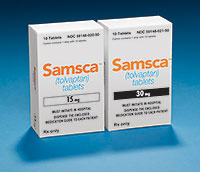Product
Samsca (tolvaptan)
Approval Date
May 21, 2009
Release Date
June 2009
Company
Otsuka Pharmaceutical Co.
Class
Oral-selective vasopressin antagonist.
Indication
For the treatment of patients with clinically significant hypervolemic and euvolemic hyponatremia (serum sodium less than 125 mEq/L, or less marked hyponatremia that is symptomatic and has resisted correction with fluid restriction) including patients with heart failure, cirrhosis and the syndrome of inappropriate anti-diuretic hormone (SIADH).
Active Ingredient
Tolvaptan
Agency Roster
Wishbone/ITP
Heartbeat Digital
Physician Outlook
Samsca (tolvaptan), the first oral selective vasopressin antagonist, expands physicians’ armamentarium of treatments for hyponatremia. However, the advantages conferred by its oral formulation are tempered by a boxed warning that administration should commence only in hospitals where blood sodium can be monitored closely. A rapid rise in sodium may lead to osmotic demyelination syndrome (ODS), a potentially life-threatening condition.
–Mary McBride, Associate Vice President, GfK Healthcare
Also in the Pipeline (courtesy of Adis R&D Insight)
Drug: VPA 985
Manufacturer: Wyeth / Biogen Idec
Indication: Hyponatraemia
Active ingredient: Lixivaptan
Phase: III
Drug: AquildaÂ
Manufacturer: sanofi-aventis
Indication: Hyponatraemia
Active ingredient: Satavaptan
Phase: Preregistration
Source: Wolters Kluwer Health
Adverse Reactions
Thirst, dry mouth, asthenia, constipation, pollakiuria, polyuria, hyperglycemia; GI bleeding (in cirrhotic patients; use only if need outweighs risk).
Adults
Initiate and re-initiate only in a hospital. Initially 15mg once daily, may increase dose after ≥24hrs to 30mg once daily, then to max 60mg once daily as needed to raise serum sodium. Avoid fluid restriction during the first 24hrs of therapy; resume fluid restriction after drug discontinuation.
Children
Not recommended.
Contraindications
Urgent need to raise serum sodium acutely. Inability of patient to sense or appropriately respond to thirst. Hypovolemic hyponatremia. Concomitant strong CYP3A inhibitors (eg, clarithromycin, ketoconazole, itraconazole, ritonavir, indinavir, nelfinavir, saquinavir, nefazodone, telithromycin. Anuric patients.
Precautions
Discontinue or interrupt therapy if too rapid a rise in serum sodium occurs (eg, >12mEq/L/24hrs) or if significant signs/symptoms of hypovolemia develop. Severe renal impairment. Monitor frequently for changes in serum electrolytes, volume, and neurologic status during initiation and titration. Severe malnutrition, alcoholism, advanced liver disease: slower rates of correction advisable. Monitor serum potassium in patients with potassium>5mEq/L or on drugs known to increase potassium. Pregnancy (Cat.C). Nursing mothers: not recommended.
Interactions
Potentiated by CYP3A inhibitors, grapefruit juice; avoid moderate CYP3A inhibitors (eg, erythromycin, fluconazole, aprepitant, diltiazem, verapamil). Antagonized by CYP3A inducers (eg, rifampin, rifabutin, rifapentin, barbiturates, phenytoin, carbamazepine, St. John’s wort); avoid. Concomitant P-gp inhibitors (eg, cyclosporine); consider reducing tolvaptan dose. Monitor digoxin. Concomitant hypertonic saline: not recommended.









